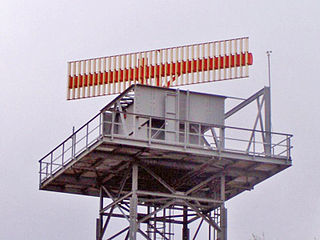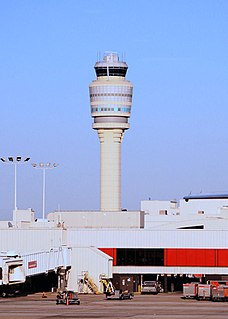
In telecommunication, a transponder is a device that, upon receiving a signal, emits a different signal in response. The term is a portmanteau of transmitter and responder. It is variously abbreviated as XPDR, XPNDR, TPDR or TP.

Secondary surveillance radar (SSR) is a radar system used in air traffic control (ATC), that not only detects and measures the position of aircraft, i.e. bearing and distance, but also requests additional information from the aircraft itself such as its identity and altitude. Unlike primary radar systems that measure the bearing and distance of targets using the detected reflections of radio signals, SSR relies on targets equipped with a radar transponder, that replies to each interrogation signal by transmitting a response containing encoded data. SSR is based on the military identification friend or foe (IFF) technology originally developed during World War II, therefore the two systems are still compatible. Monopulse secondary surveillance radar (MSSR), Mode S, TCAS and ADS-B are similar modern methods of secondary surveillance.

Precision approach radar (PAR) is a type of radar guidance system designed to provide lateral and vertical guidance to an aircraft pilot for landing, until the landing threshold is reached. After the aircraft reaches the decision height (DH) or decision altitude (DA), guidance is advisory only. Controllers monitoring the PAR displays observe each aircraft's position and issue instructions to the pilot that keep the aircraft on course and glidepath during final approach. It is similar to an instrument landing system (ILS) but requires control instructions. One type of instrument approach that can make use of PAR is the ground-controlled approach (GCA). Air traffic controllers must transmit a minimum of every 5 seconds to the pilot their relation to the azimuth portion and, once intercepting the glidepath, their elevation. The approach is terminated when the aircraft reaches the OCA/H. Nevertheless, information is provided until threshold and aircraft may be monitored by controller until touchdown. Controller in charge of PAR should not be responsible for any duty other than the PAR approach concerned.
Air traffic control in Australia is provided by two independent organisations, one civilian and one military. The civilian provider is Airservices Australia, which controls civilian airfields and airspace. The military provider is the Royal Australian Air Force (RAAF), which controls military airfields and adjoining airspace. This includes Australian Army and Royal Australian Navy aviation bases. Some airfields in Australia are categorised as Joint User airfields, where there are both civilian and military operations based at the airfield. Normally, Joint User airfields have air traffic control provided by the RAAF.

Skyguide is an air navigation service provider which manages and monitors Swiss airspace. The company, which was formerly known as Swisscontrol, changed its name to skyguide in 2001. Skyguide is a joint-stock company under Swiss private law which is responsible, on behalf of the Swiss Confederation, for ensuring the safety of all Swiss airspace and of adjoining airspace areas in Germany, Austria, France and Italy that have been delegated to its control. For Swiss airspace, this duty extends to both civil and military air navigation services.

An airport surveillance radar (ASR) is a radar system used at airports to detect and display the presence and position of aircraft in the terminal area, the airspace around airports. It is the main air traffic control system for the airspace around airports. At large airports it typically controls traffic within a radius of 60 miles (96 km) of the airport below an elevation of 25,000 feet. The sophisticated systems at large airports consist of two different radar systems, the primary and secondary surveillance radar. The primary radar typically consists of a large rotating parabolic antenna dish that sweeps a vertical fan-shaped beam of microwaves around the airspace surrounding the airport. It detects the position and range of aircraft by microwaves reflected back to the antenna from the aircraft's surface. In the US the primary radar operates at a frequency of 2.7 - 2.9 GHz in the S band with a peak radiated power of 25 kW and an average power of 2.1 kW. The secondary surveillance radar consists of a second rotating antenna, often mounted on the primary antenna, which interrogates the transponders of aircraft, which transmits a radio signal back containing the aircraft's identification, barometric altitude, and an emergency status code, which is displayed on the radar screen next to the return from the primary radar. It operates at a frequency of 1.03 - 1.09 GHz in the L band with peak power of 160 - 1500 W.
The Future Air Navigation System (FANS) is an avionics system which provides direct data link communication between the pilot and the air traffic controller. The communications include air traffic control clearances, pilot requests and position reporting. In the FANS-B equipped Airbus A320 family aircraft, an Air Traffic Services Unit (ATSU) and a VHF Data Link radio (VDR3) in the avionics rack and two data link control and display units (DCDUs) in the cockpit enable the flight crew to read and answer the controller–pilot data link communications (CPDLC) messages received from the ground.

The 117th Air Control Squadron is Georgia Air National Guard air control unit headquartered in Hunter Army Airfield, Savannah. It provides theater command with air battle management, radar surveillance, air space control, and long haul communication capabilities to plan and execute combined air operations; air superiority and air strike ground attack operations, and provides state authorities with a dedicated force ready to react to local and national emergencies.

A transponder is an electronic device that produces a response when it receives a radio-frequency interrogation. Aircraft have transponders to assist in identifying them on air traffic control radar. Collision avoidance systems have been developed to use transponder transmissions as a means of detecting aircraft at risk of colliding with each other.
In aviation a ground-controlled approach (GCA), is a type of service provided by air-traffic controllers whereby they guide aircraft to a safe landing, including in adverse weather conditions, based on primary radar images. Most commonly a GCA uses information from either a Precision Approach Radar or an Airport Surveillance Radar. The term GCA may refer to any type of ground radar guided approach such as a PAR, PAR without glideslope or ASR. When both vertical and horizontal guidance from the PAR is given, the approach is termed a precision approach. If no PAR glidepath is given, even if PAR equipment is used for lateral guidance, it is considered a non-precision approach.

Operations Specialist is a United States Navy and United States Coast Guard occupational rating. It is a sea duty-intensive rating in the Navy while the majority of Coast Guard OS's are at ashore Command Centers.
Aircraft vectoring is a navigation service provided to aircraft by air traffic control. The controller decides on a particular airfield traffic pattern for the aircraft to fly, composed of specific legs or vectors. The aircraft then follows this pattern when the controller instructs the pilot to fly specific headings at appropriate times.
The National Airspace System (NAS) is the airspace, navigation facilities and airports of the United States along with their associated information, services, rules, regulations, policies, procedures, personnel and equipment. It includes components shared jointly with the military. It is one of the most complex aviation systems in the world, and services air travel in the United States and over large portions of the world's oceans.

An optical landing system (OLS) is used to give glidepath information to pilots in the terminal phase of landing on an aircraft carrier. From the beginning of aircraft landing on ships in the 1920s to the introduction of OLSs, pilots relied solely on their visual perception of the landing area and the aid of the Landing Signal Officer. LSOs used coloured flags, cloth paddles and lighted wands. The OLS was developed after World War II by the British and was deployed on U.S. Navy carriers from 1955. In its developed form, the OLS consists of a horizontal row of green lights, used as a reference, and a column of vertical lights. The vertical lights signal whether the aircraft is too high, too low, or at the correct altitude as the pilot descends the glide slope towards the carrier's deck. Other lights give various commands and can be used to require the pilot to abort the landing and "go around." The OLS remains under control of the LSO, who can also communicate with the pilot via radio.

The Air Traffic Organization (ATO) is America's air navigation service provider, as the operations arm of the Federal Aviation Administration. Its customers are commercial and private aviation and the military, and it employs more than 35,000 controllers, technicians, engineers and support workers.

PIRAZ is a United States Navy acronym for Positive Identification Radar Advisory Zone. The zone is defined by the air search radar coverage of a ship patrolling a designated PIRAZ station. The concept was similar to radar picket stations established in World War II. The PIRAZ ship requires a Naval Tactical Data System radio-linked computer installation to effectively identify and track all aircraft anticipated to enter the airspace of the zone during combat.

Automatic dependent surveillance—broadcast (ADS–B) is a surveillance technology in which an aircraft determines its position via satellite navigation and periodically broadcasts it, enabling it to be tracked. The information can be received by air traffic control ground stations as a replacement for secondary surveillance radar, as no interrogation signal is needed from the ground. It can also be received by other aircraft to provide situational awareness and allow self-separation.

Aviation communication refers to the conversing of two or more aircraft. Aircraft are constructed in such a way that make it very difficult to see beyond what is directly in front of them. As safety is a primary focus in aviation, communication methods such as wireless radio are an effective way for aircraft to communicate with the necessary personnel. Aviation is an international industry and as a result involves multiple languages. However, as deemed by the International Civil Aviation Organization (ICAO), English is the official language of aviation. The industry considers that some pilots may not be fluent English speakers and as a result pilots are obligated to participate in an English proficiency test.
This is a list of the acronyms and abbreviations used in avionics.


















